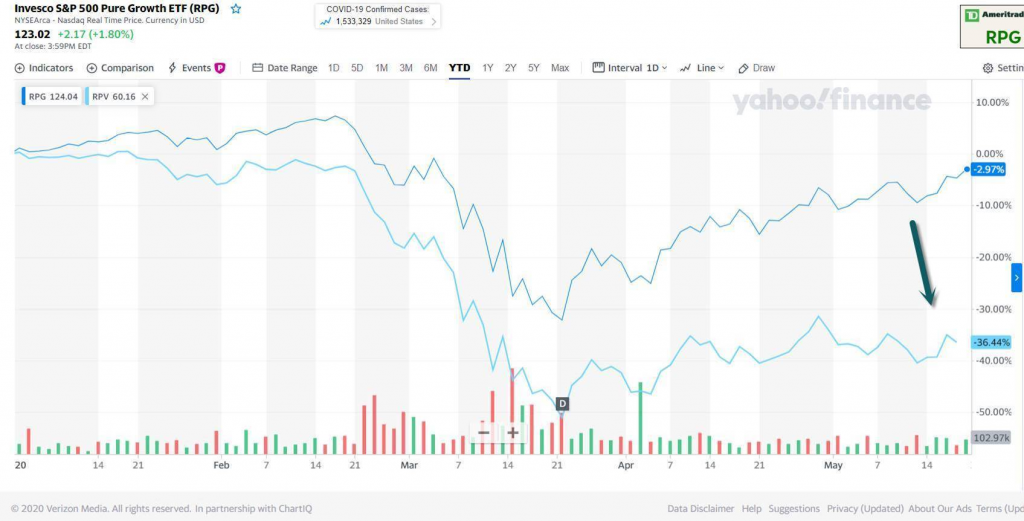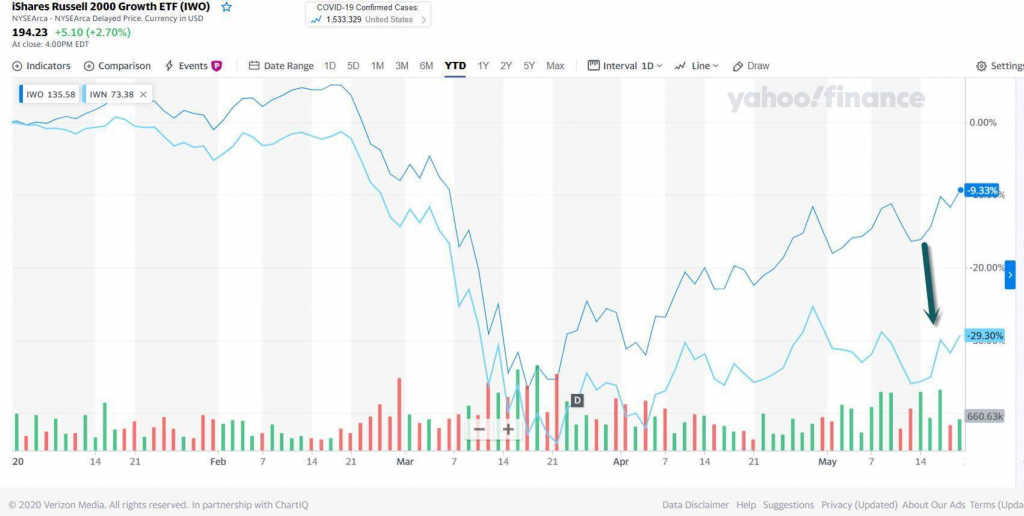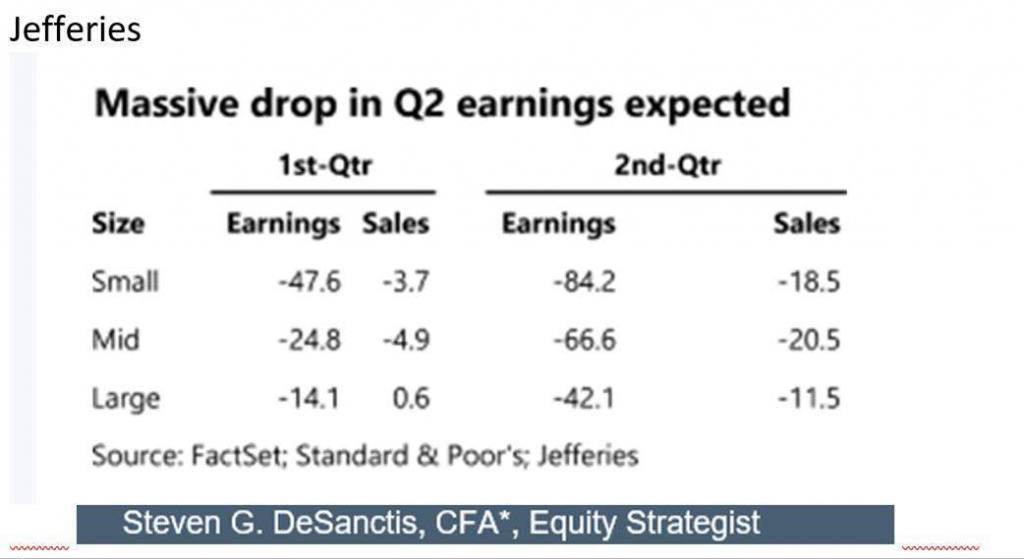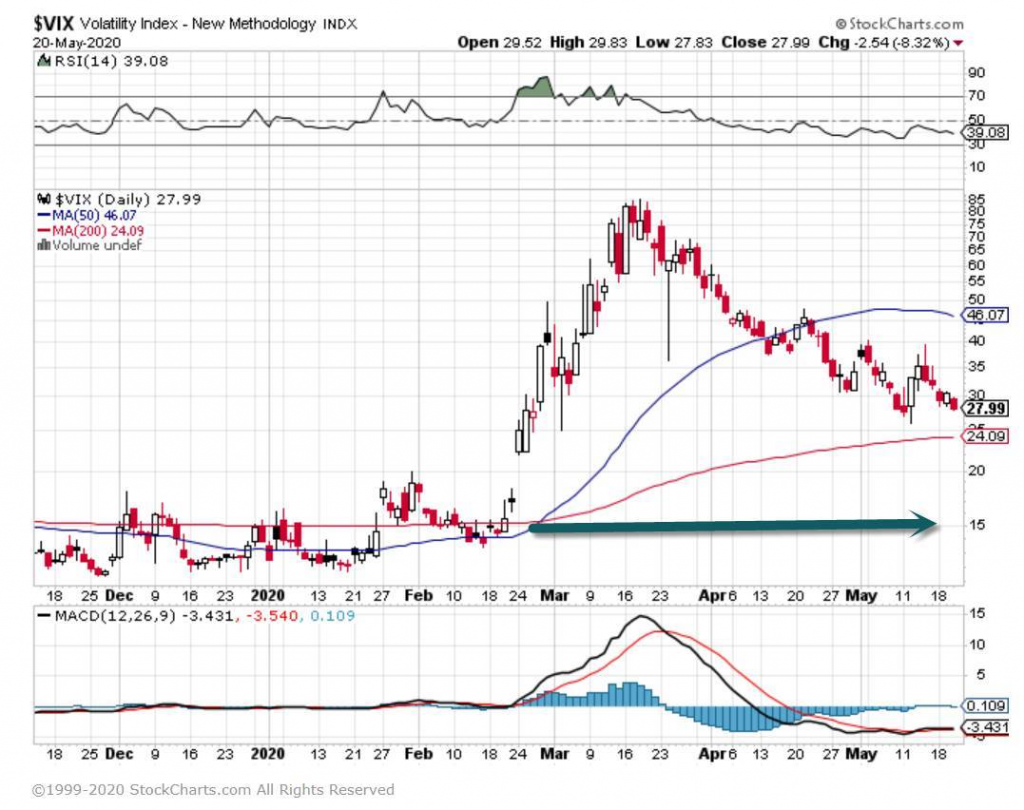1.Large Cap Growth Dominating Performance
Not Sure If This Is Record Spread…RPG S&P 500 Pure Growth -3% YTD vs. RPV S&P 500 Pure Value -36% YTD
2.Mega-Cap 50 ETF XLG -2% YTD vs. RSP Large Cap Equal Weight -16%
3.Small Cap Growth IWO -9% YTD vs. Small Cap Value -30%
4.Massive Drop in Q2 Earnings Small Cap Estimate -84%
Jefferies
5.One of the Pent Up Demand Arguments is a Large Contingency Took Forbearance That Did Not Need It.

A $150 Billion Pile of Frozen Loans Starts to Worry U.S. Banks
Jenny Surane and Hannah Levitt
The rapid rollout of forbearance programs in March averted financial ruin for millions of households, giving Congress time to bolster unemployment benefits and offer emergency aid to businesses. The goal was to avoid a tidal wave of defaults by borrowers who began losing income when states locked down commerce to slow infections. More than 30 million people have since filed jobless claims.
But many lenders offered to postpone bills with no proof of hardship, and many borrowers kept working. Some signed up for the programs as a precaution, taking a break from payments to shore up their savings. That’s made it impossible for banks to gauge the degree to which their loan portfolios are at risk of going bad.
Some mid-sized banks placed more than 15% of their loan books into forbearance by the end of March, Janney Montgomery Scott analysts wrote in a report last week. In regions like the U.S. Southeast, relatively high rates of borrower relief contrasted with low infection rates at the time. Many programs have remained open since then, continuing to take on borrowers who have fallen on hard times.
On average, banks had about 5% of their consumer loan portfolios on ice as of mid- to late-April, analysts at Keefe, Bruyette & Woods wrote in a report this month that compiled disclosures from about 80 large, regional and community banks. Based on Federal Reserve data, that would equate to roughly $150 billion in loans — though the amount may have climbed since then.
https://finance.yahoo.com/news/150-billion-pile-frozen-loans-120007449.html
6.Volatility Index Well Off Highs in 80’s But Still in 20-30 Range.
VIX above the long-term bull levels below 20
7.Sector Performance Reflects Growth Dominance.
Best & Worst Sector ETFs Of The Year- Sumit Roy https://www.etf.com/sections/features-and-news/best-worst-sector-etfs-year
8.J.P. Morgan Chart Showing Infection Rates Declining in States Where Lockdowns Ending.
9.Study Shows 70% of Consumers Would Rather Watch New Movies at Home (EXCLUSIVE)
A new consumer survey reveals deepening dread over public venues — and some surprising changes in popular taste.
By Adam B. Vary
For weeks now, as COVID-19 restrictions across the country begin to ease (or, in some cases, even where they haven’t), national and local news outlets have relentlessly reported on a seeming torrent of people streaming into public spaces. The coverage points to a common sense understanding: Spending two months sheltering in place with little-to-no human contact has produced an overpowering need for people to gather together outside their homes.
According to an exclusive new study, however, that media coverage belies a deeper truth: Anxiety over health and safety in public spaces still greatly outweighs the desire to leave home, and that disparity has only gotten larger as the pandemic has unfolded. The results — from a survey of roughly 1,000 people in mid-May by sports and events analytics firm Performance Research, in partnership with Full Circle Research Co. — point to just how steep a climb the entertainment industry has in front of it to win back public perception that it’s safe to attend, and spend money on, public events again.
Take this answer to the question of whether respondents would rather see a first-run feature as a digital rental at home or in a movie theater, if both were available today: A whopping 70% say they are more likely to watch from their couch, while just 13% say they are more likely to watch at a local cinema (with 17
10.The Hard Way is the Easy Way
In my previous essay, I argued that much of success boils down to a simple maxim: do the real thing and stop doing fake alternatives.
Always start by asking yourself: “How would I do this, if doing it well were all that mattered?”
Now, you might object: You don’t have enough time. You have a job, kids and responsibilities. Doing it well sounds too daunting.
This is okay. The point of this thought experiment isn’t to deny that obstacles exist. Rather, it’s to start with the best plan and make accommodations as needed. What results is usually much closer to the ideal than if you simply start with something that feels easy enough.
How Would You Do It, If Doing It Well Were All That Mattered?
Let’s look at some examples:
You want to learn a language. The best plan is full immersion. You can’t do this completely though, so you make some exceptions for work, friends or family members. In the end, you only spend 60% of your conversation time speaking the new language.
In contrast, imagine you start by asking what’s something easy you can do? Now you end up downloading an app, listening to a podcast or telling yourself you’ll speak it “as much as you can.” The result? Maybe 1% of your conversation time is in the language. Maybe you never use it to communicate at all.
Say you want to start a business. The best plan is to build a prototype immediately of your intended product. You start interviewing prospective clients, getting preorders or contact information. But you can’t do this perfectly—you can’t quit your job yet and you can’t get financing.
The resulting path, however imperfect, is still a hell of a lot better than randomly reading business books or printing business cards or whatever convenient activity would have replaced it.
Maybe you want to get in shape. You figure the ideal path is to plan meals and stick to a precise workout schedule. You have to modify this to fit your life, but it gets you further than just buying a standing desk or telling yourself you really should try to exercise more often.
The Paradox of Difficulty
A pattern in my own life, and one you may have seen as well, is that the hardest things end up becoming the easiest, once you’ve fully committed to them.
Most pursuits have some unavoidable effort. You can either choose to commit that effort, or find ways to pretend it doesn’t exist.
If you choose to commit, you make the pursuit a priority. You put it first in your calendar. You expect frustration, setbacks and obstacles. You’ve made yourself stronger, instead of trying to avoid lifting the weight.
Paradoxically, it’s those who ignore the investment needed that experience the highest costs. It’s hard to hit a target when you’re aiming out of the corner of your eye. Difficulties arise precisely when you expect things to be easy.
How to Commit to the Hard Way
The way forward is simple. It just isn’t easy:
1. Begin with what would work best.
Start with what would work best. Hold the buts and whatabouts for later. Merely asking what the ideal strategy would be doesn’t yet commit you to it. But it forces you to recognize the effort inherent in the path ahead.
Focus on what you’d be doing, not how much. The “what” turns your attention to the real thing. “How much” matters too, but it should come after. While intensity can be scaled, the real thing doesn’t have easy substitutes.
2. Make the best possible to attain.
Starting with what would work, you now ask how you could make it possible.
Maybe the real thing is inaccessible. You want to learn a language, but you’re stuck at home. You want to work in a real firm, but they won’t hire you. You want access to the training ground, but it’s off-limits.
Now is the time for substitutions. Approximating the real thing is tricky, but it’s far better than efforts that don’t even strive for verisimilitude.
You can’t travel, but you aim for immersion at home. You can’t work in the real office, but you train on the tools they use. The training ground is off-limits, so you build your own in your backyard.
3. Turn the hard way into the easy way.
Now, and not a moment sooner, is the time for engineering ease into your efforts.
The timing is critical. Starting with what’s easy, you’ll be tempted to substitute something convenient for something that works. Once you know what needs to be done, however, do everything you can to make it easier to execute.
Smooth friction. Ask for help. Cultivate good habits, systems and routines. Throw every hack, trick or tactic you have at the problem to make the path a little less treacherous.
If You’re Not Willing to Do it Well, Why Be Willing to Do It at All?
The hard way forces a choice: are you willing to invest the effort required to do it right?
As with any real choice, sometimes the answer is no. The cost is too high, other obligations take precedence or you simply don’t care enough. No is always a valid answer. Better to say it now, than let it rot away your resolve over time.
But if your answer is yes, then you know the path. All that’s left is to walk it.












